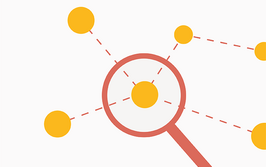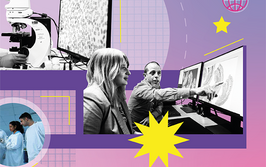
The Need for (Sequencing) Speed
Rapid whole genome sequencing of NICU patients can save costs and improve health and quality of life
At a Glance
- Genetic disorders are difficult to diagnose in newborn babies – but spotting these diseases is critical
- Early diagnosis of genetic diseases can help target treatment, reduce costs, and improve patients’ health and quality of life
- We recommend rapid whole genome sequencing (rWGS) for as many NICU patients without clear diagnoses as possible
- To make sure rWGS reaches every patient who might benefit, we aim to make it a first-tier reimbursable test
When your newborn baby is in intensive care, nothing matters except finding the reason for the illness and treating it. No parent given a choice would consider sparing any effort or expense that seemed likely to provide an answer. And yet, diseases in newborns often go undiagnosed, or are diagnosed only later in life. Why? In many cases, it’s because they have a genetic disorder – a problem often missed in the neonatal intensive care unit (NICU). And those that are less common are more difficult to spot. For some patients, the diagnostic delay can mean the difference between life and death – and for others, it can have an immeasurable impact on future health or quality of life. What can be done to help them?
Rapid whole genome sequencing (rWGS) is a rapidly emerging methodology that can aid in providing timely diagnoses for children in the NICU. However, due to concerns regarding the cost and accessibility of the testing, as well as the lack of reimbursement, the approach has not been widely adopted. Genetic disease is thought to be the leading cause of death in the NICU – but all too often, children (especially those who don’t exhibit the classic symptoms of genetic disorders) remain without a genetic diagnosis. Newborn babies often fall into this category, and so doctors don’t necessarily consider sequencing – even in the event of an undiagnosed illness. But it can be a costly mistake. Rapid whole genome sequencing (rWGS) can save weeks of diagnostic uncertainty, enable early and effective treatment, prevent unnecessary interventions, and discharge infants earlier – and in better health.
A pressing need
There are approximately 8,000 genetic diseases that can affect patients in the NICU. And in acutely ill babies, conventional testing is often too slow to help guide prompt and appropriate disease management. rWGS provides a powerful approach to help diagnose children in the NICU quickly, guide their medical management, and ultimately yield better outcomes.
Neonates can be extremely difficult to diagnose and treat in comparison with older infants and children. Because these children are so young, many of the classic signs and symptoms by which we commonly identify genetic syndromes have not yet presented. Moreover, with acutely ill newborns in the ICU, medical decision-making often happens in seconds – whereas in other settings, fast action may not be as critical. Overall, there are thousands of neonates in the United States who are not being sequenced, but could benefit significantly from the testing.
How do we test?
The pipeline at Rady Children’s Institute for Genomic Medicine is calibrated to process genomes as fast as possible. Our bioinformatics pipeline allows us to process a genome in 45 minutes, followed by rapid analysis, interpretation and reporting. In routine genome-wide sequencing, on the other hand, price is a more significant factor than speed (and immediate answers may not be as critical) – so patients often wait for some time before receiving results. In our Clinical Genome Center, we process samples for acutely ill babies as soon as they reach the laboratory. It’s exciting that we recently validated our new Illumina NovaSeq 6000 high-throughput sequencing system, which will allow us to process up to 12 genomes in 24 hours. This builds on our previously validated HiSeq2500 and HiSeq4000 instruments. We continue to build our infrastructure to scale our ability to provide as many rWGS tests as we can.
The optimal use of sequencing is to provide rapid results that allow us to take better care of children with a suspected genetic disorder. We continue to push the boundaries of this testing and expand the criteria for the kids we sequence. I think that we honestly do not know how many of these kids have genetic diseases – and we have had multiple instances in which we have found diagnoses in children after initially thinking that the chances of discovering something genetic were very small. Now, there are certain exclusion criteria in our studies – isolated prematurity, for instance – but we are really trying to broaden our approach and not select only cases we think have a high likelihood of being genetic. We are focused on the clinical utility and medical management of these children.
We enrolled our first Rady Children’s patient in July of 2016 and have been fortunate enough to have gathered multiple success stories in the short time since. We made a recent diagnosis in a child with uncontrolled seizures within 39 hours of receiving a blood sample. This guided the therapeutic path for the child, who received a radical change in diet along with vitamin B6 and other supporting therapies that are not first-line seizure medications. With the help of genomic information, the physicians were able to control the seizures.
In another case, outlined in TIME magazine (1), we made a molecular diagnosis within 96 hours in a newborn with uncontrolled seizures. That diagnosis allowed us to provide targeted medication that stopped the seizures and allowed the baby to rapidly improve. She was discharged from the NICU in 18 days. Almost a year later, the child continues to develop normally; in fact, she is exceeding all expectations! This story starkly contrasts with that of a Rady Children’s Hospital patient who was born a year before we started performing WGS. That child had an extended stay in the NICU, did not receive the same molecular diagnosis for six weeks, and is now seriously neurologically compromised.
The overall snapshot of our results is that we are able to provide a diagnosis for 30 to 40 percent of children. But the number we are most proud of is that 70 percent of the children we diagnose receive a change in medical management while they are still in the hospital – it really shows the medical benefit of this testing. We can customize treatment quickly and effectively, and work toward better outcomes for our youngest, sickest patients.
Spreading the word
We have been really impressed with the responses of the physicians we have spoken to regarding WGS, and with their willingness to adopt it. It’s never easy to bring such a disruptive technology into a unit as specialized and critical as the NICU, but the physicians and nurses we’ve worked with have been great advocates for our mission. And it’s a winning situation for everyone – especially the patients. For children in whom we never suspected a genetic disease, not only did the diagnosis come as a surprise, but it supported dramatic improvements in their care.
How do we share this revolution with a broader audience? Our immediate goal is to provide insurance companies with data supporting the clinical utility and cost-effectiveness of rWGS so that it can become a first-tier reimbursed test; we must partner with various companies and institutions to make this happen, so we’re hoping to work with increasing numbers of children’s hospitals. The more patients we can reach with rWGS testing now, the faster we’ll be able to make it an accessible test for every patient.
We envision a day when the medical team can order and secure this testing for any child in intensive care who needs it. Insurance coverage without preauthorization will reduce the lag time in recognizing the value of rapid implementation of precision medicine. We also hope to keep working to bring the costs and time down for rWGS. We believe the advent of this technology in the clinic will require dedication and resources – and we’ll need to establish genomics education across all specialties of medicine. Our hope is that, in the future, we’ll see enthusiastic adoption of all of these steps – and the life-saving value of genomics will be widely recognized.
- A Park, “Genetic testing is providing new hope for babies born with mysterious ailments” (2017). Available at: ti.me/2fkRSM6. Accessed November 21, 2017.
Shimul Chowdhury is Clinical Laboratory Director at Rady Children’s Institute for Genomic Medicine, San Diego, USA.
David Dimmock is Senior Medical Director at Rady Children’s Institute for Genomic Medicine, San Diego, USA.




















